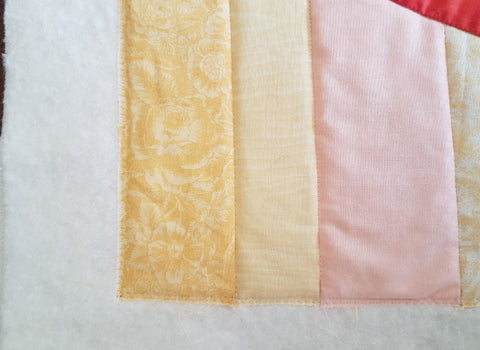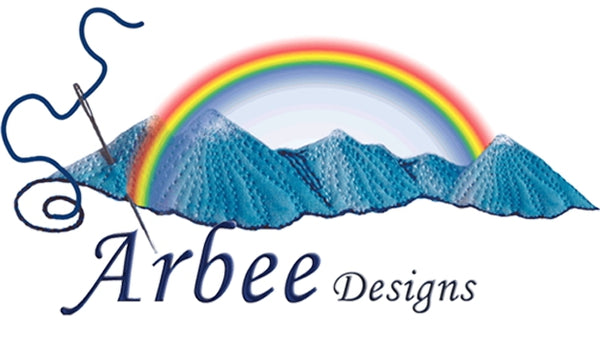No matter what we do or how careful we are, there will always be movement in the fabric simply because of the way fabric is constructed - it is woven so creates a bias which is stretchy even if only a little bit.
Knowing this, to make squaring up your quilt easier, it always pays to square up your blocks as you are creating them. You will find if your blocks are square, there will be less imperfection in your quilt, although you should still check to see if your quilt needs squaring up. It likely will still need a little adjustment.
So before I explain how to square up your quilt, I feel it is important to explain how to square up a block.
Squaring Up Quilt Blocks
Your square ruler makes squaring up a breeze. The diagonal line down the middle means that when you square something, the two parts are equal halves - no guess work needed. It helps even more when you are trimming a block that has that diagonal seam.
Put your block on the cutting board. Put your square ruler on it with the small numbered end at the top. Note: I am right handed so will trim down the right hand side of the ruler and along the top. If you are left handed, twist the ruler around as you will be cutting down the left hand side of the ruler and along the top.


Before trimming, look at the interior of the ruler. This unit should be 2 1/2". You should see the fabric either directly ON the 2 1/2" lines or extending slightly beyond it. If it is too short, adjust your ruler. If you cannot, you have made a mistake so figure out what that is now before proceeding.

Notice that the 2 1/2" line on the rule (right and bottom edges) are within the fabric of the block, the diagonal line matches the seam line and the edges (left and top) of the fabric extend beyond the ruler. The latter will be trimmed off.
When squaring a half square triangle (as in the above photo) or a block with a diagonal seam through the middle, the diagonal line of the ruler will rest directly on that diagonal seam line.
When squaring up with a four-patch, you have a center point. Make sure that center point of the block is at the center point of the ruler. For example, if you square up a 4 1/2" block, the center point will be at the 2 1/4" mark on the ruler which is half of the size of the block.

Trim the first two sides - for me being right handed, that is the right side and the top as shown in the picture. If you are left handed, rotate the rule 45 degrees anti-clockwise and trim the left hand side and the top.
After the first two sides have been trimmed, the block is rotated 180 degrees so you can trim the second two sides making sure the sides just trimmed are lined up exactly on the correct ruler markings.

trim the second sides after your ruler is aligned with the block edges and seams
Squaring Up Your Quilt
Once your piece is quilted, you need to make the edges even and square before adding your binding. It is easier and more accurate to trim the quilt sandwich if the three layers are sewn together at the edge. Otherwise, the bottom layer can shift and you end up with edges that are not the same.
The best way to sew the layers together is to use a walking foot. I use a basting stitch and zigzag down the very edge of the quilt top. Your stitches should be less than 1/4" wide so they will not show once the binding is attached.

Using a walking foot helps keep the layers feeding through evenly. If you do not have a walking foot, you can use lots of pins to hold it in place while you stitch however if you have thick batting it is probably better to baste the edges by hand.
After you have stitched the edge, the next step is to trim away the excess batting and backing.
Lay the quilt on your cutting board with the top and one side in position for trimming. If your table is too small for the quilt, support the weight of the quilt so that it is not pulling at the edges where it hangs over the edge of the table. If you quilt is large, you will need long rulers. Using two rulers is best. I find a large square (16") and long ruler (24") works perfectly.
Use the large square ruler at the corner of your quilt. Use a long ruler butted up to the square ruler to extend down the first side of your quilt. This will allow you to trim around the corner and know that you are making a right angle.

If you have added a border use the lines on the ruler to match up with the interior seam. Note: Make sure as you move the ruler around your quilt that you are aligning that interior seam with the same mark on your ruler.
Go ahead and trim making sure your healing mat is under the area of your quilt you are trimming.
Move the ruler down the length of your quilt. Align the ruler with your interior seam (if you have one) and overlap the previously cut edge enough so that you know you are still trimming in a straight line. I usually make the overlap at least 6".
As you get to the bottom, you will do the same thing as you did at the top, using your square ruler to make another perfect right angle corner. Continue in this manner all the way around the quilt.
When you have finished, check you haven't trimmed off the basting. Baste any areas again. It is important that the three layers be sewn together so they will act like one piece of fabric as you sew on your binding.



1 comment
Thank you for the very clear direction!